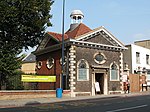Christ the King Sixth Form College

Christ the King Sixth Forms are sixth form colleges based over three sites in South London, England. The college was first founded in 1992 by the Catholic Church on a site in Lewisham owned by the Archdiocese of Southwark, it welcomes students from all religions and backgrounds. The college is a free-standing institution responsible for its own affairs. The original site in Lewisham is called Christ the King: Emmanuel. The college is run by its Principal and senior staff, whose appointment is one of the tasks of the governing body. The Church provides guidelines to ensure that the institution retains its Catholic ethos. The college is also accountable to its public funder, the Education Funding Agency.
Excerpt from the Wikipedia article Christ the King Sixth Form College (License: CC BY-SA 3.0, Authors, Images).Christ the King Sixth Form College
St Joseph's Vale, London Blackheath (London Borough of Lewisham)
Geographical coordinates (GPS) Address External links Nearby Places Show on map
Geographical coordinates (GPS)
| Latitude | Longitude |
|---|---|
| N 51.464166666667 ° | E -0.0025 ° |
Address
Christ the King Sixth Form College
St Joseph's Vale
SE3 0XQ London, Blackheath (London Borough of Lewisham)
England, United Kingdom
Open on Google Maps








